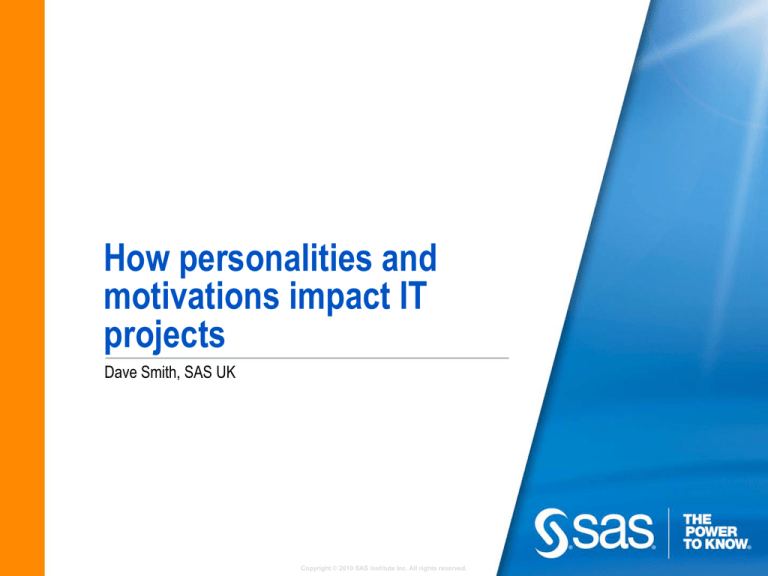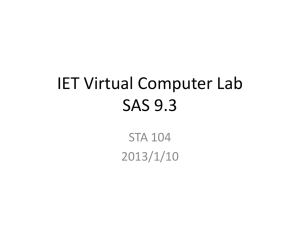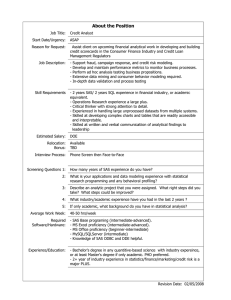
How personalities and
motivations impact IT
projects
Dave Smith, SAS UK
Copyright © 2010 SAS Institute Inc. All rights reserved.
Disclaimer
The paper is built upon experiences both within
and outside the pharmaceutical industry and the
character types are built upon the sum total of
many different people rather than individuals. On
no account should the audience attempt to identify
themselves
2
Copyright © 2010, SAS Institute Inc. All rights reserved.
Project Failure Rates
Project Failure rates are extremely high
• 68% of companies are more likely to have a marginal project or
outright failure than a success - IAG Consulting
• Their report blames most failures on the way organisations
approach business analysis
• They picked projects that involved major business change, so
that might be a skewed analysis.
3
Copyright © 2010, SAS Institute Inc. All rights reserved.
Project types – Business Sponsor Led
Strategic projects
•
•
•
•
Aligned with the overall organisation’s strategy
Clear understanding of future state and desired outcome
Usually successful
Can fail if business requirements are uncontrolled
Tactical projects
• Often initiated to deal with an immediate crisis or to
make a small incremental efficiency gain.
• Can proliferate where there are restrictions on project
initiation - leads to inefficiencies
• Sometimes characterised by in-house builds and poor
validation practices
4
Copyright © 2010, SAS Institute Inc. All rights reserved.
Project types – External Led
Software led
• Initiated when a new software package is seen as the
simplest fix
• Initiated by the business or IT
• Initiated at many different levels of the organisation
Systems Integrator led
• Almost always associated with senior level
sponsorship
• Usually have good ROI cases
• Usually associated with strategic business
requirements.
5
Copyright © 2010, SAS Institute Inc. All rights reserved.
The main characters and their
motivations
6
Copyright © 2010, SAS Institute Inc. All rights reserved.
The Permanent Employee
The Newbie
• Only been in post a little while
• Sometimes unsure of their ability to meet expectations
• Often see change as a threat and may become defensive
The Experienced Contributor
•
•
•
•
Often cynical due to experience of many change programs
Maybe good evangelists for the project if aligned
Can be vital to the success of the project
First line managers will often rely upon their opinions
The Corporate Climber
• Aspires to become a manager
• Projects are opportunities or threats… react accordingly
• Opinions strongly influenced by their perception of their managers’
opinions
7
Copyright © 2010, SAS Institute Inc. All rights reserved.
The Contract employee
The Positive Contractor
• Looks for new opportunities to enhance role or capabilities
• See projects as an opportunity to gain a new skill
A Defensive Contractor
• Sees change as a potential threat to their position
• Look for tactical opportunities to cement themselves in an
organisation, particularly through in-house applications
An Incompetent Contractor
• Just about manages to do the tasks required and will see any
change as a threat
• May attempt to undermine projects to avoid being exposed as
incompetent.
8
Copyright © 2010, SAS Institute Inc. All rights reserved.
First line manager 1
A Defensive Manager
• Try to ensure projects are not a threat to themselves or
their team
• Will not oppose projects if no perceived threat
• Will support projects if they or their team become stronger
An Ambitious Manager
• If they see personal advancement then they will champion
projects
• At any sign of failure they will distance themselves rapidly
• May take a political stance on a project; if it has no direct
effect upon them but is good for a rival they may oppose
the project.
9
Copyright © 2010, SAS Institute Inc. All rights reserved.
First line manager 2
A Goal Oriented Manager
• Will ensure that the project is delivered and will champion the
success of the project throughout its lifespan.
• More focused upon delivering business needs than furthering
their own personal ambitions
A Peter Principle Manager
• Generally incompetent, has been promoted to a level where
they can do no more harm
• Tend to survive by being not being associated with either
success or failure, delegating everything to subordinates and
only managing upwards
• Can adversely affect projects by failing to focus requirements
gathering on the important elements and allowing minutiae to
distract progress.
10
Copyright © 2010, SAS Institute Inc. All rights reserved.
Senior Business Manager
A Leader
• Will direct both strategy and implementation
• Will not shy away from making uncomfortable decisions
• Will bring the business along with them and ensure that the project is well
supported during implementation and roll-out.
A Politician
• Will be less clear in their decision making
• Will ensure that the opinions of (other) senior executives are reflected in
their actions.
• Will ensure that other stakeholders are aligned to its success.
A Guided Leader
• Takes advice from an external party, usually a Systems Integrator but
occasionally a software vendor
• They tend to have a strong previous association with the third party
• Can ensure a strong relationship with that organisation.
11
Copyright © 2010, SAS Institute Inc. All rights reserved.
IT
IT Business Partner
• Role to meet business needs
• Must maintain IT architecture and software standards
• Can act as gatekeepers and prevent IT projects being initiated
• Mostly ensure that IT projects have a realistic chance of success
IT Architect
• Encompasses a number of roles
• Those who design systems for a particular project
• Those who design the enterprise IT infrastructure
• Tend to create and enforce software and hardware standards
• Should prevent dysfunctional architectures
IT Decision Maker
• Often the project budget holder
• Keen to ensure any project with his or her name on it will succeed and have a positive
impact on the business
• They will seek the guidance of their architecture standards team
• Support is often the difference between project success and failure.
• Some are One Trick Ponies…
12
Copyright © 2010, SAS Institute Inc. All rights reserved.
Vendors
Software Salesperson
• Must sell in the current year or sometimes quarter
• Failure means they lose their job…succeed or move on
• A good salesperson can have a massive impact on a project - the software will be fit
for purpose and the commercials arranged in a mutually beneficial manner.
Software Technical Consultant
• Technical consultants (presales or implementation) have longer term relationships with
customers
• Can properly understand companies
• Can act as honest brokers (although will benefit from sales)
Systems Integrator
• Measured on the number of hours they can bill to projects
• Large SI’s have a very driven culture
• Most consultants are incredibly hard working and develop very good business skills.
• Place high value on reputation
• Can try to over deliver on customer expectations, not always sufficiently critical of
customer requirements
13
Copyright © 2010, SAS Institute Inc. All rights reserved.
Company Culture
Notoriously hard to change a company’s culture
• Common advice: “come back when they’ve retired”
When implementing a project this must be
considered especially in the adoption phases
• Need to work within not against prevailing culture
Some organisations are overly political
• Project can become a pawn in political manoeuvring.
14
Copyright © 2010, SAS Institute Inc. All rights reserved.
Powerful combinations
An Ambitious Manager with an Experienced Contributor
• Can be incredibly effective for a small tactical project
• Experienced Contributor delivers the project
• Ambitious manager sweeps away objections and corporate inertia
• Core relationship between the two major players is key
• Ambitious Manager ensures that any success is well recognised
A Leader and a Goal-Oriented First Line manager
• Possibly the most powerful combination of all
• Leader ensures project support across all levels of the organisation
• Goal-Oriented FLM concentrates upon the success of the most important
deliverables
A Guided Leader with a good Systems Integrator
• Might seem like a recipe for thousands of consultants on site delivering nothing
but documents…
• If the SI is good and the guided leader has sufficient background with SIs this
can be incredibly effective
15
Copyright © 2010, SAS Institute Inc. All rights reserved.
What Success Looks Like
Strategic Direction
•
•
•
•
Aligned with operating model/company strategy
Explained in common language
Functional collaboration with all levels of the business
Pick the most negative and the most positive for pilot teams
An uncompromised technical solution
• Closest to COTS as can be managed
• Used in the way it was designed
Well managed change
• Either guided by a Systems Integrator or through capable
management
• A capable organisation to take the solution forward postimplementation
• Train, skills transfer, on-going support
16
Copyright © 2010, SAS Institute Inc. All rights reserved.
Conclusions
Technology is only a very small part of the success or
failure of projects
• People factors have a far greater impact
• Cultural/organisational factors must be factored in
I have hardly touched the surface of this subject
• Team personality types (e.g. Myers Briggs)
• KPI alignment
• Organisational Capability
I hope this promotes discussion among the audience.
17
Copyright © 2010, SAS Institute Inc. All rights reserved.
A powerful combination!
18
Copyright © 2010, SAS Institute Inc. All rights reserved.
Copyright © 2010 SAS Institute Inc. All rights reserved.



